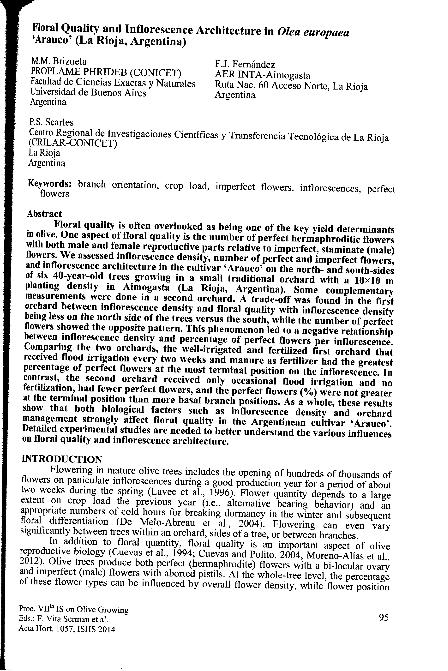Mostrar el registro sencillo del ítem
dc.contributor.author
Brizuela, Maria Magdalena

dc.contributor.author
Fernández, F. J.
dc.contributor.author
Searles, Peter Stoughton

dc.date.available
2017-01-27T21:35:21Z
dc.date.issued
2014-11
dc.identifier.citation
Brizuela, Maria Magdalena; Fernández, F. J.; Searles, Peter Stoughton; Floral Quality and Inflorescence Architecture in Olea europaea 'Arauco' (La Rioja, Argentina); International Society for Horticultural Science; Acta Horticulturae; 1057; 11-2014; 95-100
dc.identifier.issn
0567-7572
dc.identifier.uri
http://hdl.handle.net/11336/12152
dc.description.abstract
Floral quality is often overlooked as being one of the key yield determinants in olive. One aspect of floral quality is the number of perfect hermaphroditic flowers with both male and female reproductive parts relative to imperfect, staminate (male) flowers. We assessed inflorescence density, number of perfect and imperfect flowers, and inflorescence architecture in the cultivar ‘Arauco’ on the north- and south-sides of six 40-year-old trees growing in a small traditional orchard with a 10×10 m planting density in Aimogasta (La Rioja, Argentina). Some complementary measurements were done in a second orchard. A trade-off was found in the first orchard between inflorescence density and floral quality with inflorescence density being less on the north side of the trees versus the south, while the number of perfect flowers showed the opposite pattern. This phenomenon led to a negative relationship between inflorescence density and percentage of perfect flowers per inflorescence. Comparing the two orchards, the well-irrigated and fertilized first orchard that received flood irrigation every two weeks and manure as fertilizer had the greatest percentage of perfect flowers at the most terminal position on the inflorescence. In contrast, the second orchard received only occasional flood irrigation and no fertilization, had fewer perfect flowers, and the perfect flowers (%) were not greater at the terminal position than more basal branch positions. As a whole, these results show that both biological factors such as inflorescence density and orchard management strongly affect floral quality in the Argentinean cultivar ‘Arauco’. Detailed experimental studies are needed to better understand the various influences on floral quality and inflorescence architecture.
dc.format
application/pdf
dc.language.iso
eng
dc.publisher
International Society for Horticultural Science
dc.rights
info:eu-repo/semantics/openAccess
dc.rights.uri
https://creativecommons.org/licenses/by-nc-sa/2.5/ar/
dc.subject
Branch Orientation
dc.subject
Crop Load
dc.subject
Imperfect Flowers
dc.subject
Inflorescences
dc.subject
Perfect Flowers
dc.subject.classification
Horticultura, Viticultura

dc.subject.classification
Agricultura, Silvicultura y Pesca

dc.subject.classification
CIENCIAS AGRÍCOLAS

dc.title
Floral Quality and Inflorescence Architecture in Olea europaea 'Arauco' (La Rioja, Argentina)
dc.type
info:eu-repo/semantics/article
dc.type
info:ar-repo/semantics/artículo
dc.type
info:eu-repo/semantics/publishedVersion
dc.date.updated
2017-01-27T13:15:33Z
dc.journal.volume
1057
dc.journal.pagination
95-100
dc.journal.pais
Bélgica

dc.journal.ciudad
Leuven
dc.description.fil
Fil: Brizuela, Maria Magdalena. Consejo Nacional de Investigaciones Científicas y Técnicas. Oficina de Coordinación Administrativa Ciudad Universitaria. Plantas Tóxicas y Medicinales, Metabolismo de Compuestos Sintéticos y Naturales - Hongos que Intervienen en la Degradación Biológica; Argentina. Universidad de Buenos Aires. Facultad de Ciencias Exactas y Naturales; Argentina
dc.description.fil
Fil: Fernández, F. J.. Instituto Nacional de Tecnología Agropecuaria; Argentina
dc.description.fil
Fil: Searles, Peter Stoughton. Consejo Nacional de Investigaciones Científicas y Técnicas. Centro Regional de Investigaciones Cientificas y Transferencia Tecnológica de Anillaco; Argentina
dc.journal.title
Acta Horticulturae

dc.relation.alternativeid
info:eu-repo/semantics/altIdentifier/url/http://www.actahort.org/books/1057/1057_9.htm
dc.relation.alternativeid
info:eu-repo/semantics/altIdentifier/url/http://dx.doi.org/10.17660/ActaHortic.2014.1057.9
Archivos asociados
